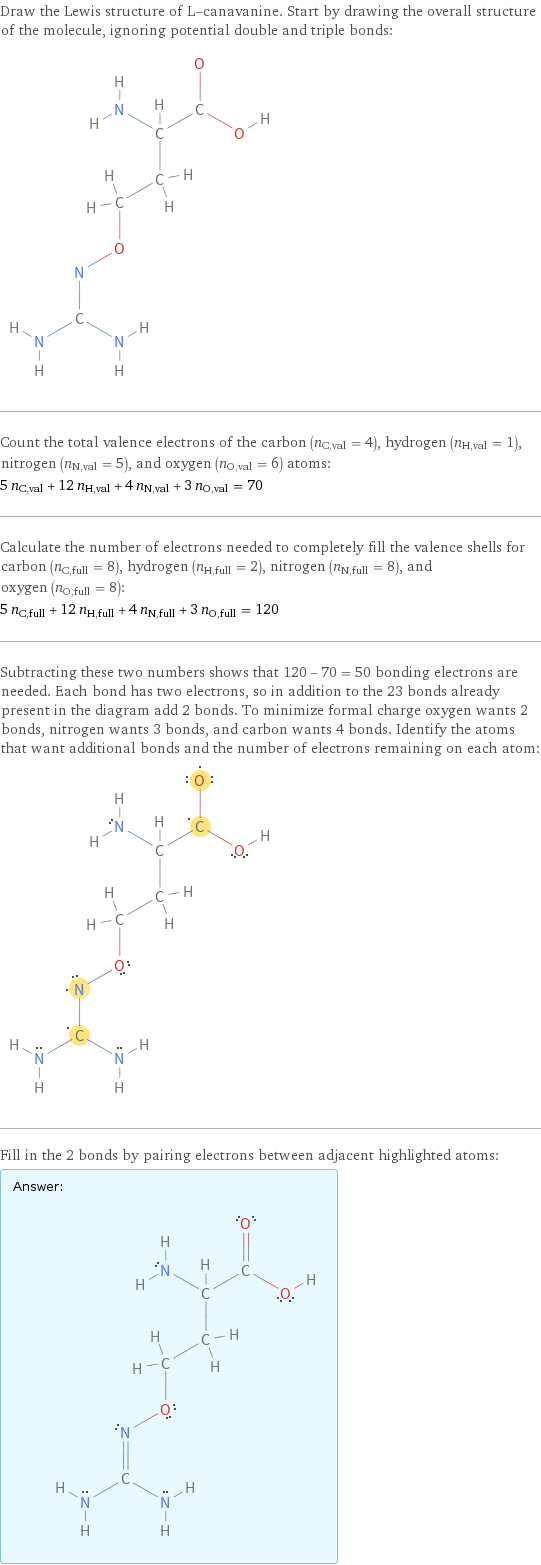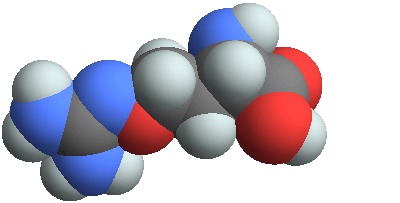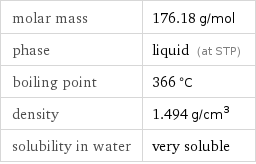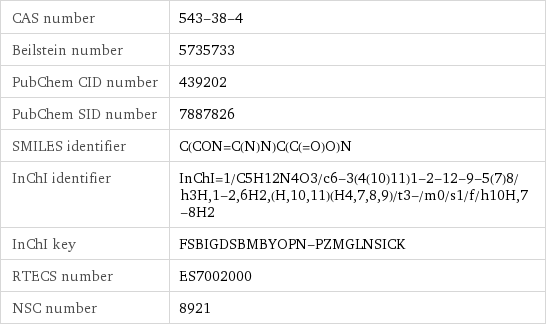Input interpretation

L-canavanine
Chemical names and formulas

formula | C_5H_12N_4O_3 name | L-canavanine IUPAC name | (2S)-2-amino-4-(diaminomethylideneamino)oxy-butanoic acid alternate names | canavanin | canavanine | L-a-amino-g-(guanidinooxy)-N-butyric acid mass fractions | C (carbon) 34.1% | H (hydrogen) 6.87% | N (nitrogen) 31.8% | O (oxygen) 27.2%
Lewis structure

Draw the Lewis structure of L-canavanine. Start by drawing the overall structure of the molecule, ignoring potential double and triple bonds: Count the total valence electrons of the carbon (n_C, val = 4), hydrogen (n_H, val = 1), nitrogen (n_N, val = 5), and oxygen (n_O, val = 6) atoms: 5 n_C, val + 12 n_H, val + 4 n_N, val + 3 n_O, val = 70 Calculate the number of electrons needed to completely fill the valence shells for carbon (n_C, full = 8), hydrogen (n_H, full = 2), nitrogen (n_N, full = 8), and oxygen (n_O, full = 8): 5 n_C, full + 12 n_H, full + 4 n_N, full + 3 n_O, full = 120 Subtracting these two numbers shows that 120 - 70 = 50 bonding electrons are needed. Each bond has two electrons, so in addition to the 23 bonds already present in the diagram add 2 bonds. To minimize formal charge oxygen wants 2 bonds, nitrogen wants 3 bonds, and carbon wants 4 bonds. Identify the atoms that want additional bonds and the number of electrons remaining on each atom: Fill in the 2 bonds by pairing electrons between adjacent highlighted atoms: Answer: | |
3D structure

3D structure
Basic properties

molar mass | 176.18 g/mol phase | liquid (at STP) boiling point | 366 °C density | 1.494 g/cm^3 solubility in water | very soluble
Units

Hydrophobicity and permeability properties

predicted LogP hydrophobicity | -3.85 predicted LogS | -1.8
Basic drug properties

approval status | experimental | small molecule
Liquid properties (at STP)

density | 1.494 g/cm^3 vapor pressure | 2×10^-6 mmHg (at 25 °C)
Units

Thermodynamic properties

molar heat of vaporization | 67.2 kJ/mol specific heat of vaporization | 0.381 kJ/g (at STP)
Chemical identifiers

CAS number | 543-38-4 Beilstein number | 5735733 PubChem CID number | 439202 PubChem SID number | 7887826 SMILES identifier | C(CON=C(N)N)C(C(=O)O)N InChI identifier | InChI=1/C5H12N4O3/c6-3(4(10)11)1-2-12-9-5(7)8/h3H, 1-2, 6H2, (H, 10, 11)(H4, 7, 8, 9)/t3-/m0/s1/f/h10H, 7-8H2 InChI key | FSBIGDSBMBYOPN-PZMGLNSICK RTECS number | ES7002000 NSC number | 8921
Safety properties

flash point | 175 °C
Toxicity properties

RTECS classes | mutagen